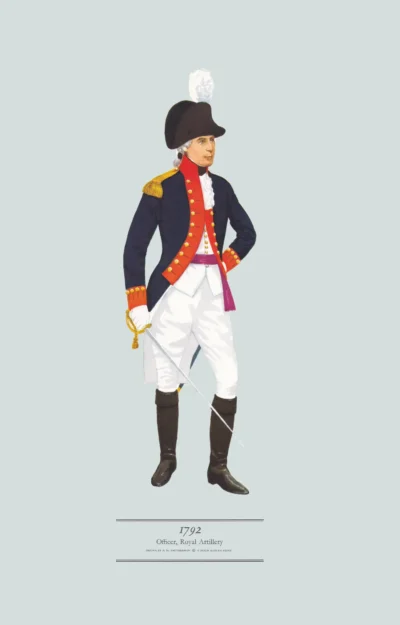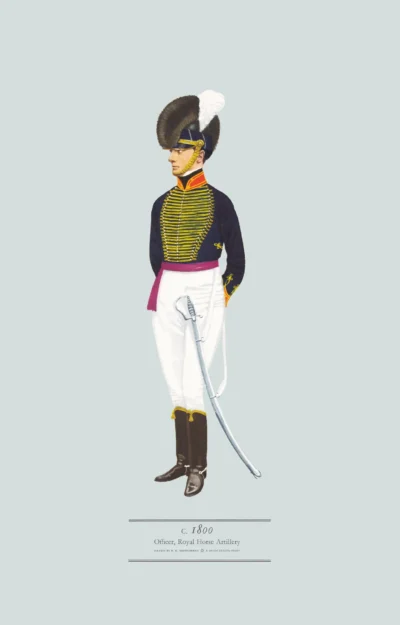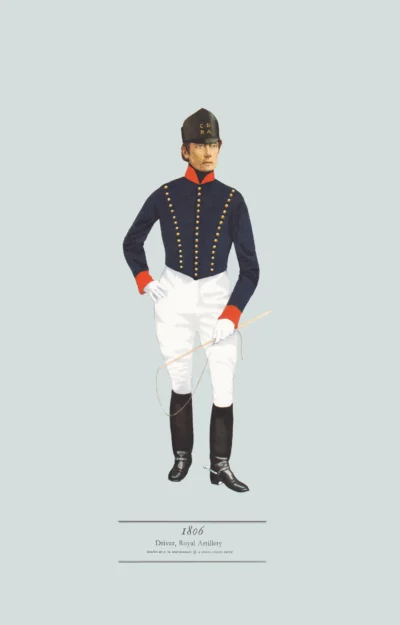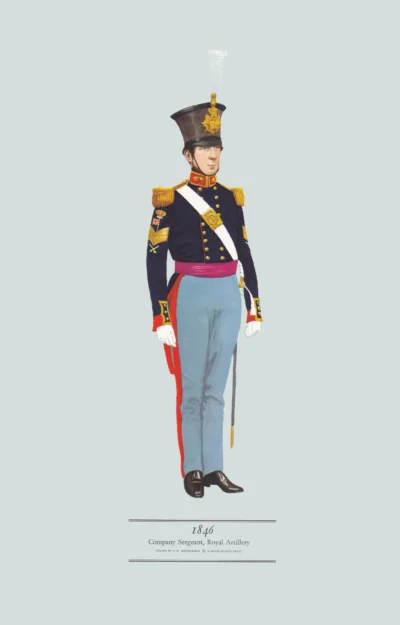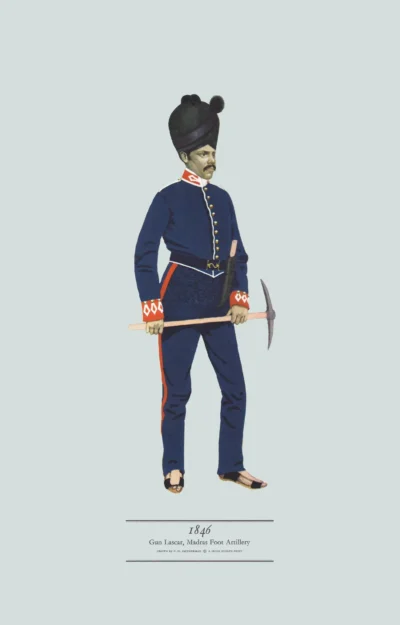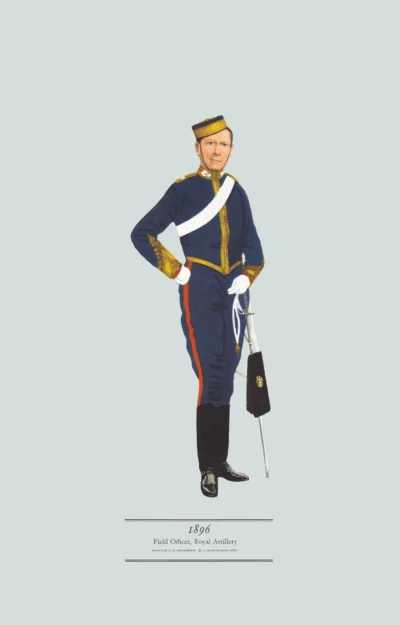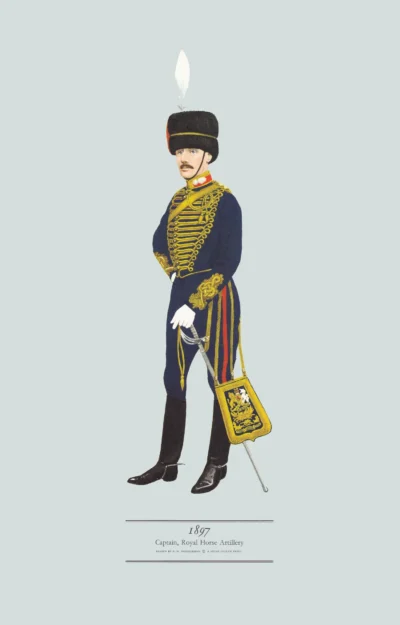The Royal Artillery and Royal Horse Artillery
Gunpowder was invented in China during the late Tang dynasty (the ninth century). Knowledge of gunpowder spread – perhaps through the Mongol conquests of the 13th century or perhaps along the Silk Road. A written formula for it appeared in the 1267 Opus Majus written for Pope Clement IV (P: 1265-1268) by Roger Bacon in England. His recipe for “blackpowder” said: “of saltpetre take five parts, five of young willow (charcoal) and five of sulfur and so you will make thunder and lightning.” English cannon saw its first use as the Hundred Years War [1337-1463] with France began, when Edward III (1312-1377) used cannon at the Battle of Crécy (1346) against the army of French King, Philip VI (1268-1314).
Masters of Ordinance and the Office of Master General of the Ordinance were created by Henry V (1386-1422) in 1415. Early guns were ‘guns of position,’ used in defence of castles, but not easily moved until the middle of the 15th century as wheels and carriages improved. King Henry VII (1509-1547) appointed a Master Gunner at the Tower of London and Master Gunners were appointees at castles where they were responsible for maintaining the armament and training the gunners (who were civilians). Henry VIII (1491-1547) created the Office of Ordinance (later the Board of Ordinance) in 1544. The Board of Ordinance and the Master General of the Ordinance came to organise trains of artillery, allot guns and master gunners, hire horses and drivers, and appoint army officers to control them. In action, gunners were assisted by soldiers who could were available. As gunnery became more technical the new ranks of firemaster, fireworker and bombardier were introduced. Trains of artillery became exceptionally large. The train used in the siege of Lille in 1708 contained 100 guns, 60 mortars, 3,000 wagons and 15,000 horses. In 1715 a train organised for use against the Jacobites was not ready until after the campaign was over.
John Churchill, 1st Duke of Marlborough, had been re-appointed Master General of the Ordinance in 1714. Under his reforms, by Royal Warrant of George I (1660-1727), two regular companies of field artillery, each 100 men strong, were raised at Woolwich, South of the river Thames in East London on May 26th, 1716. Initially based at the Royal Arsenal barracks, after 50 years they moved to their own new barracks on Woolwich Common in 1770. They were titled the “Royal Regiment of Artillery” (RA) in 1720. In 2007 the headquarters of The Royal Artillery finally moved to Larkhill on Salisbury Plain in Wiltshire, where the bulk of the Regiment had been based for some years. This garrison town started as a tented barracks with a firing range in 1899 and since the range was suited for artillery practice the base began to be used more frequently by the Royal Artillery. After World War I the base became an artillery stronghold and in 1919 the Royal School of Artillery was established there. Shortly before World War II the famous British Ordnance QF 25-pounder was developed by the school of artillery at Larkhill.
In India, the artillery of the Honourable East India Company had developed along lines similar to those of the Royal Artillery: each presidency – Bengal, Bombay and Madras – maintained its own Horse and Foot Artillery which by 1830 totalled 24 Horse Artillery troops and 70 Foot Artillery companies. When the mutiny occurred in 1817 only 7 Indian units defected, the remainder, British and Indian, behaved with impeccable bravery. In 1859 it was decided all artillery in India would be British. The Indian units were suspended, and the European transferred to the Royal Artillery. By the end of the Napoleonic wars the Royal Artillery had seen little active service whereas the artillery of the East India company had been constantly engaged. At the time of the mutiny the Bengal Horse Artillery claimed to be the most efficient artillery in the world. The influx of these new units not only increased the size of the Royal Artillery by half but introduced units of the highest traditions and efficiency. For this reason, many Royal Artillery units have Indian origins and bear Indian battle honours of which they are justly proud. At the time of the amalgamation the regiment was completely reorganised. The Board of Ordinance was abolished in 1855 after which the regiment, like the rest of the army, came under the command of the C-in-C. The field artillery was organised into self-contained batteries, like the RHA, and men were enlisted into the regiment to be either gunners or drivers or both.
In 1899, the Royal Artillery was divided into three groups: the Royal Horse Artillery (RHA) and the Royal Field Artillery (RFA) composed one group, the coastal defence, mountain, siege and heavy batteries another group, the Royal Garrison Artillery (RGA) and the Royal Artillery, which was responsible for ammunition storage and supply. When the Volunteer Force and the Yeomanry in the United Kingdom (including the Volunteer Artillery) were merged to create the Territorial Force in 1908, the Militia Artillery was re-designated the Special Reserve The division of the Royal Regiment of Artillery lasted until 1924, when the RFA, RHA, and RGA amalgamated once more to become one regiment. In 1938, RA Brigades were renamed regiments. During World War II over 1 million men served in 960 gunner regiments. In 1947 the Riding Troop RHA was renamed the King’s Troop Royal Horse Artillery and, in 1951, the title of the regiment’s colonel-in-chief became Captain General. When The Queen first visited the Troop after her accession, it was expected that it would become “The Queen’s Troop”, but Her Majesty announced that in honour of her father’s decision it would remain “The King’s Troop”.
The Royal Horse Artillery, which has separate traditions, uniforms and insignia, still retains a distinct identity within the regiment. Before World War II, Royal Artillery recruits were required to be at least 5 feet 4 inches (1.63 m) tall. Men in mechanised units had to be at least 5 feet 8 inches (1.73 m) tall. They initially enlisted for six years with the colours and a further six years with the reserve or four years and eight years. They trained at the Royal Artillery Depot in Woolwich. Despite the move of the Royal Artillery to Larkhill in 2007, in 2012 the King’s Troop, Royal Horse Artillery was relocated to Woolwich from their former headquarters in St John’s Wood.




